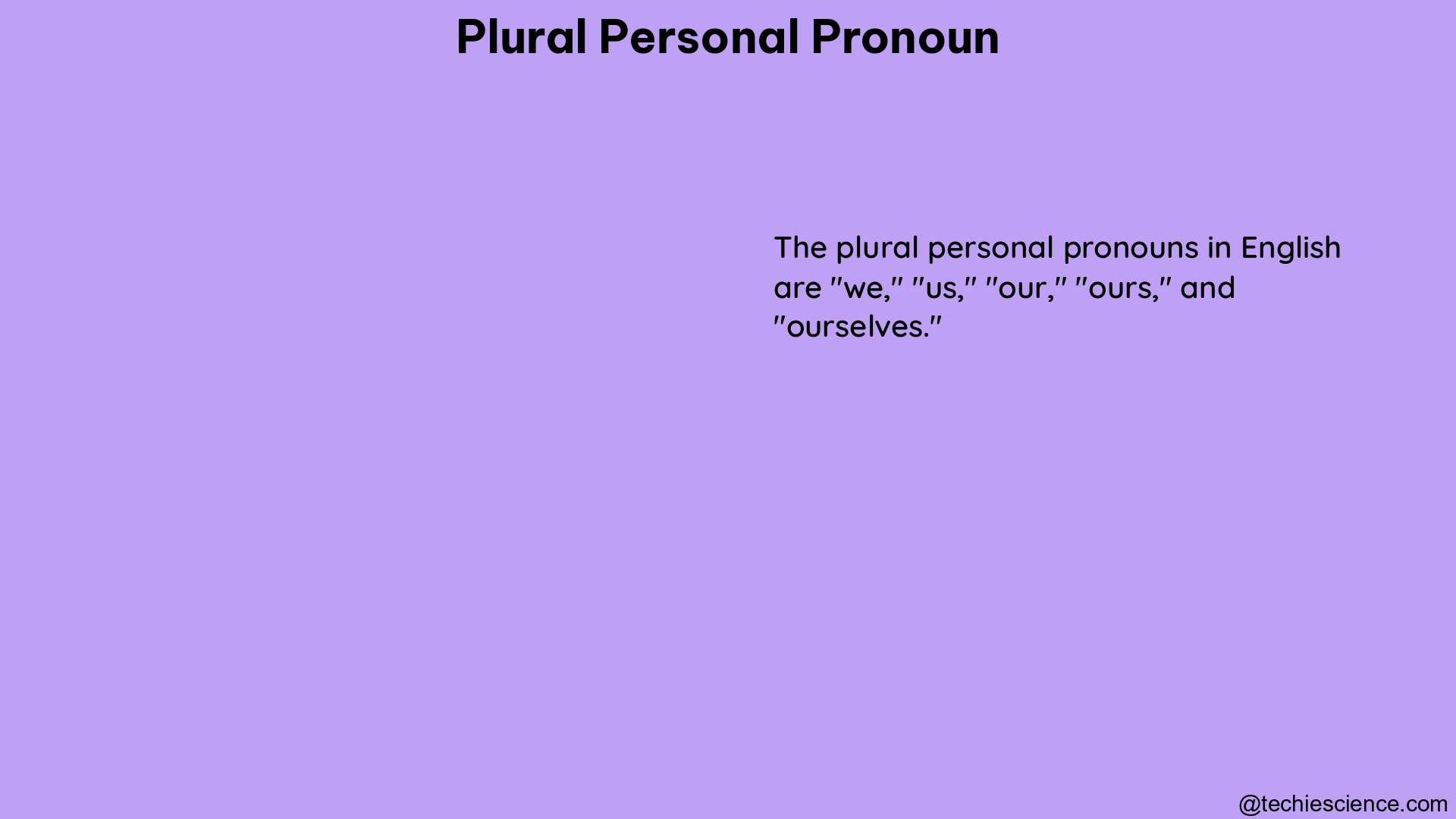Plural personal pronouns are a crucial component of the English language, serving as essential tools for effective communication and grammatical precision. These unique words replace plural nouns or groups of nouns, allowing speakers and writers to avoid repetition and maintain a smooth, cohesive flow in their discourse. In this comprehensive guide, we will delve into the intricacies of plural personal pronouns, exploring their categories, grammatical specifications, and providing a wealth of examples to solidify your understanding.
Categories of Plural Personal Pronouns
Plural personal pronouns can be divided into three distinct categories: first person, second person, and third person. Each category serves a specific purpose and carries its own set of unique characteristics.
First Person Plural Pronouns
First person plural pronouns are used to describe a single group or multiple groups in which the speaker is included. The primary first person plural pronouns are “we” and “us.”
Example:
– Rick and I ran in the local fun run. → We ran in the local fun run.
Second Person Plural Pronouns
Second person plural pronouns are used to replace groups that the speaker is addressing. The second person plural pronoun is “you.”
Example:
– John and Mike, you need to listen to what I am saying. → You need to listen to what I am saying.
Third Person Plural Pronouns
Third person plural pronouns refer to groups that the speaker is speaking about. The third person plural pronouns are “they” and “them.”
Example:
– Bob and Macy went to the movies. → They went to the movies.
Grammatical Specifications of Plural Personal Pronouns

Plural personal pronouns have specific grammatical characteristics that govern their usage and function within a sentence. These specifications include number, case, and gender.
Number
Plural personal pronouns are used to replace plural nouns or groups of nouns. They are divided into singular and plural forms, with the plural forms being “we,” “us,” “you,” “they,” and “them.”
Case
Plural personal pronouns can serve as subjects, objects, or possessive pronouns, depending on their role in the sentence.
- Subject pronouns: “We,” “You,” “They”
- Object pronouns: “Us,” “You,” “Them”
- Possessive pronouns: “Our,” “Your,” “Their”
Gender
While English does not have a grammatical gender system for nouns, it does have gender-specific pronouns for people. For example, “he” and “she” are used for singular third-person pronouns, and “they” is used for plural third-person pronouns.
Detailed Examples of Plural Personal Pronouns
To further illustrate the usage of plural personal pronouns, let’s examine a series of examples:
- First Person Plural Pronouns:
- We are going to the park.
- Let’s take our dog with us.
-
The team celebrated our victory with a party.
-
Second Person Plural Pronouns:
- You are all invited to the party.
- Your contributions to the project have been invaluable.
-
Did you enjoy the concert?
-
Third Person Plural Pronouns:
- They are coming over tonight.
- Give the ball to them.
- Their decision to volunteer was admirable.
In these examples, you can observe how the plural personal pronouns seamlessly replace the plural nouns or groups, maintaining grammatical coherence and avoiding repetition.
Mastering Plural Personal Pronouns: Tips and Strategies
To effectively master the usage of plural personal pronouns, consider the following tips and strategies:
-
Understand the Pronoun Categories: Familiarize yourself with the three categories of plural personal pronouns (first person, second person, and third person) and their respective pronouns.
-
Recognize Grammatical Specifications: Familiarize yourself with the grammatical specifications of plural personal pronouns, including number, case, and gender.
-
Practice with Diverse Examples: Engage in exercises that provide a wide range of examples, covering different sentence structures and contexts to solidify your understanding.
-
Pay Attention to Pronoun-Antecedent Agreement: Ensure that the plural personal pronoun you use correctly matches the number and gender of the noun or group it is replacing.
-
Utilize Pronoun Substitution Exercises: Practice replacing plural nouns or groups with the appropriate plural personal pronouns to reinforce your skills.
-
Consult Reference Materials: Refer to reliable grammar resources, such as style guides, online tutorials, and language-learning websites, to deepen your knowledge and address any uncertainties.
By following these tips and strategies, you will develop a comprehensive understanding of plural personal pronouns, enabling you to communicate effectively and with grammatical precision.
Conclusion
Plural personal pronouns are an essential component of the English language, serving as powerful tools for clear and concise communication. By mastering the categories, grammatical specifications, and proper usage of these pronouns, you will enhance your language skills and become a more confident and effective communicator.
References
- Study.com. (n.d.). Plural Pronouns | Types & Examples – Lesson – Study.com. Retrieved from https://study.com/academy/lesson/what-are-plural-pronouns-definition-examples.html
- Grammarly. (2022, October 6). What Are Personal Pronouns? Definition and Examples – Grammarly. Retrieved from https://www.grammarly.com/blog/personal-pronouns/
- Excelsior OWL. (n.d.). Singular & Plural Pronouns – Excelsior OWL. Retrieved from https://owl.excelsior.edu/grammar-essentials/parts-of-speech/pronouns/singular-and-plural-pronouns/
- Towson University. (n.d.). PRONOUNS. Retrieved from https://webapps.towson.edu/ows/pronouns.htm
- LanGeek. (n.d.). “Personal Pronouns” in the English Grammar | LanGeek. Retrieved from https://langeek.co/en/grammar/course/2/personal-pronouns

Hi! I am Bhabesh Sing. I have completed M.A in English, M.A in Vocal Music, and B.Ed. I am a creative writer. Currently, I am a Subject Matter Expert in English on this Platform.
Let’s connect through LinkedIn-https://www.linkedin.com/in/bhabesh-sing-660914ab